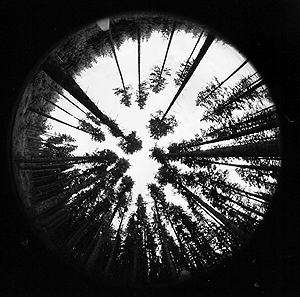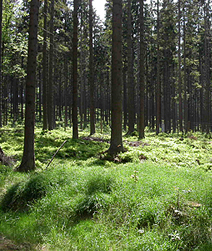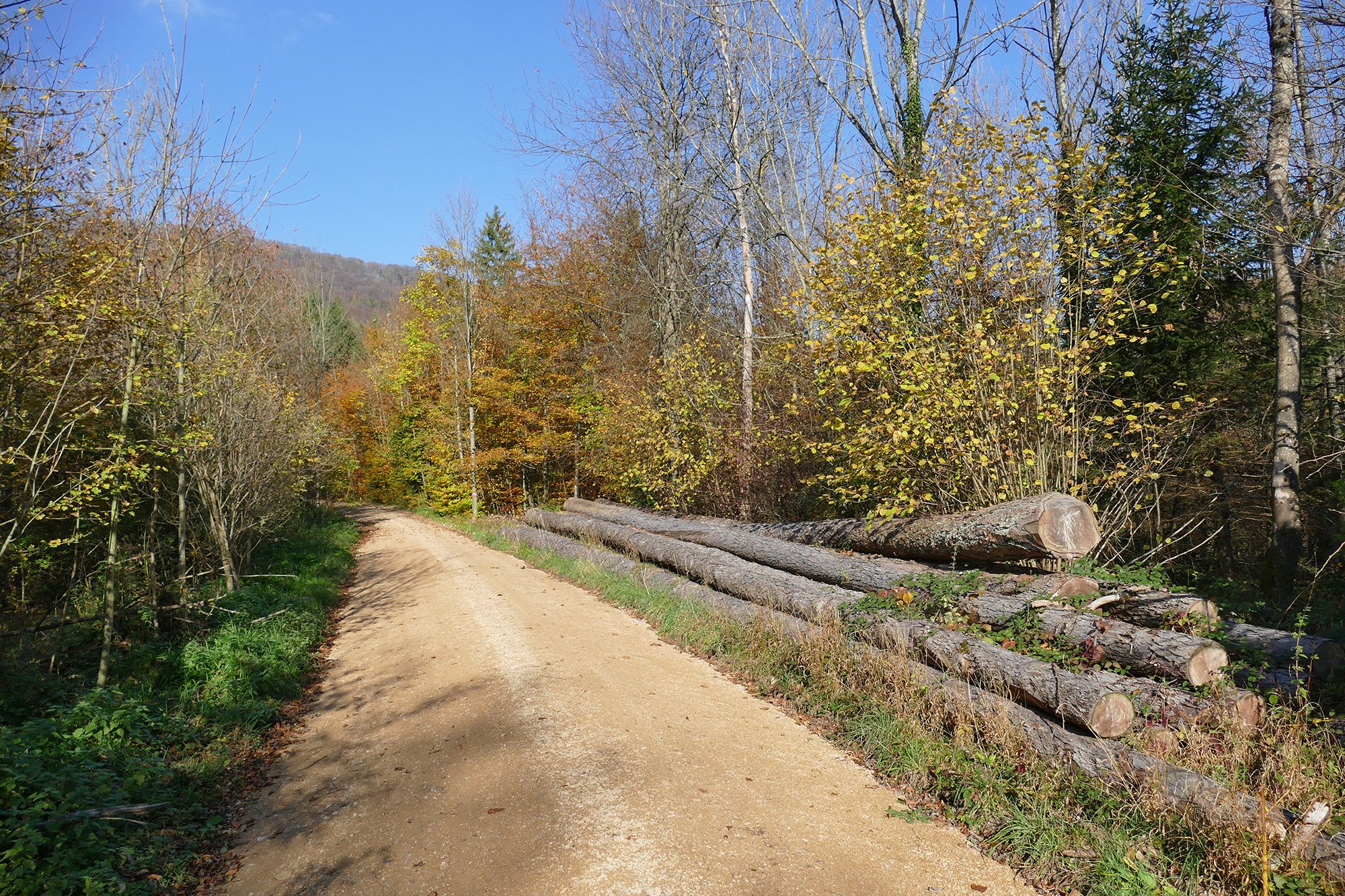
The gap fraction of a canopy is a good variable for indirect sensing of crown coverage
Underplanting of beech beneath spruce: Canopy management and harvesting regime
As a summary, the shade tolerance in seedlings is maintained by leaf orientation, morphological plasticity, low leaf construction costs, and expansion of the leaf area. As a prerequisite, species-adequate nutrient supply has to be assured. Forest management can therefore significantly improve the shade tolerance by nutrient addition on poor sites and through maintenance of the leaf area through protection against damage.
Low light intensities affect growth of the introduced plants. Oak and beech seedlings grown under slightly reduced light intensities compared to the open are taller than in the open, but stem diameter is smaller. Therefore light input does not only influence survival and growth, but also the quality of the introduced plants. Light quantity getting through the canopy to the understorey depends on canopy closure and varies within a wide range from 2 % up to 40 % of light in the open. For the forest practice, it is necessary to determine with some accuracy how the light input depends on the canopy closure of the mature spruce stand.
The gap fraction of a canopy is a good variable for indirect sensing of crown coverage, integrating canopy structure and closure. This parameter gives – within a certain angle - the fraction of visible sky, which is not blocked by the canopy, e.g. a gap fraction of 0 indicates that there is no sky visible through the canopy. The gap fraction can be measured by several methods, e.g. fisheye photography. The growth of plants under the canopy is closely related to the light input. Under optimal nutrient supply such as on the SUSTMAN site in Slovenia, there is straight response of plant growth to light intensity.
| To be able to develop underplanting of broadleaved tree species under Norway spruce trees as a silvicultural tool for conversion of Norway spruce forest, EU finances the research project SUSTMAN (QLRT: 2001 – 00851), coordination Prof. Dr. M. Kazda, University Ulm, www.sustman.de). SUSTMAN is a project involving forest researchers from Austria, Czech Republic, Germany, Slovenia and Sweden. The project is running over three years from 2002 until 2005 with a budget of about 1.6 million euros. One important task is transfer of knowledge to practical forestry. The project will therefore produce a silvicultural management guideline for European forest managers when underplanting is put into practice. This leaflet summarize the main information within that guideline which in complete form will be published in Czech, English, German and Slovenian. |
Several management implications for the introduction of broadleaved trees under Norway spruce shelterwoods can be summarized:
- Under uniform shelterwoods relative light input is directly linked to canopy density but increase slower compared to the canopy closure
- Growth of plants is linked to light input, when the nutrient supply meets the species requirement
- Protection against leaf loss due to browsing is of high importance for plant survival and performance in shade
- Initial survival and later vigour of beech plants is further influenced by water supply.
Stability of the Norway spruce stand important

Natural regeneration of spruce is significantly hampered by dense ground vegetation cover, particularly of grasses
In deciding on a suitable cutting type, stability of the Norway spruce stand to be converted plays a key role. In this context stability against storm is most important because every cutting operation affects this feature. Other threats for stability, particularly by bark beetles, are of less importance and restricted to dryer sites and years with above average temperatures.
Out in the forest the assessment is not always easy. Some stands already show signs of previous storm damage, and the degree of stability and kind of root system can be judged more effectively. These damaged parts of the stand can be used for planting of beech or maple in the first place (passive underplanting). Active underplanting starts from intentional man-made disturbances in form of usual cutting types. Passive underplanting is often the only possibility on unstable sites – with the exception of clear cutting.
The normal case on stable sites is to apply intentionally one of the four basic cutting types: Uniform shelterwood (1), Group selection cutting type (2), Strip cutting (3) and Clear-cutting (4). In practise, these basic cutting types will seldom be applied consistently. More often they will be changed or combined in a spatial or temporal pattern. As an example, a widespread cutting regime starts with a shelterwood followed by a group selection type and the final removal is performed by a rapidly progressing strip cutting.
One of the most important factors controlled by cutting type is the light intensity on the forest floor. There are many practical observations which show that the density of the canopy affects the growth form of the young trees planted underneath. However, important parameters like branching pattern, branch thickness, number of proleptic shoots, crown form, self pruning, and extent of felling and logging damages are almost not covered yet by scientific investigations connected to underplanting.
Stem form of young beeches, as expressed by the quotient of shoot length and shoot height showed that the young beech trees exhibited knee-shaped growth under dense shelter, whereas they stood almost perfectly straight in the plots with low shelter. The extent of slant of the young beeches is increasing with the canopy density of the old stands, or with decreasing light intensity. However, this relationship is not linear: with light intensities falling short of 10 % or even 15 % the mean angle of deviation of the stem axis respective of the last terminal shoot from vertical increases more and more. Obviously, there is a threshold value between 10 and 15 % light.
Cutting types which are characterized by keeping some sort of overstory for longer periods imply many repeated harvest entries. Therefore, they rely on permanent access to the stands by heavy machinery, and they need a dense network of forest roads and skidding trails. In conjunction with the higher effort for harvesting single trees, all this leads to significantly raised costs.
To prevent felling and logging damages to the planted or naturally regenerated trees a skid trail system in 20 m spacing and broad felling zones has proven very useful in Germany. These zones should not be planted, but left for natural regeneration of spruce in a later stage instead.
Basically, young beeches can grow in deep shade underneath an almost completely closed overstory, but light intensity should not remain under the above mentioned threshold of 10 – 15 % for a long period in order to avoid the deterioration of stem form.
Natural regeneration of spruce is significantly hampered by dense ground vegetation cover, particularly of grasses. Therefore, it should be initiated in an early stage of the whole cutting process. But after having been established (approximately 4-6 years after germination) the young spruces need much more light to gain sufficient height growth and a competitive advantage to beech. For this, they require definitely more than 30 % light.
In addition, the competition between these two species should be mitigated by arranging them in a groupwise mixture, with monospecific groups of at least 20 m in diameter. The successful regeneration of oaks require very large openings of the overstory spruces, or clear cuts. Only in cases without beech as a mixed species oaks can tolerate more shade, down to 20 – 30 % light.
Contact
Marian Kazda, coordination
University Ulm, Department of Systematic Botany and Ecology
Albert Einstein-Allee 11, D-89081 Ulm
